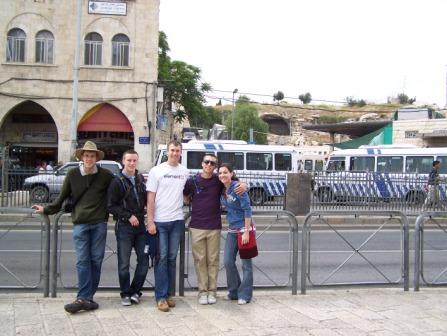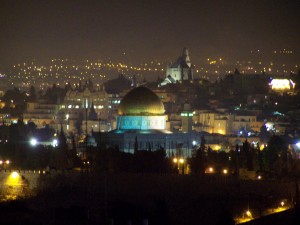I have now spent 2 nights sleeping in the Holy Land. We have been instructed that it is more politically sensitive to call it the Holy Land because some prefer Israel while others prefer Palestine. The Arab/Jewish duality in the city overwhelms every aspect of the culture here. I thought there was a big division between the east side and the west side of Salt Lake, walking from East Jerusalem into West Jerusalem is like traveling from a small, chicken-filled village in Mexico into the polished shafts of Washington DC, all in a mere 2 or 3 blocks.
I hesitate to give a bunch of history lessons but this does affect everything we do here. When the Jews kicked out the British after World War II they gained control over most of the country except three important pieces: the Golan Heights (which is the watershed for the Jordan River), the Gaza Strip, and the West Bank, where Jerusalem is. Now they desperately wanted Jerusalem (who wouldn’t?) so they had a major offensive where they pushed up a canyon in the hill country and drove a wedge into the west bank until they reached Jerusalem. They had captured about half the city up to the wall of the old city when the UN stepped in and drew some lines. For about fourteen years there was a DMZ (much like a certain wall in Berlin but not quite as bad) running down the middle of the city dividing it east and west. The Jews immigrated like crazy to fill up the West side which they controlled while Jordan maintained (sort of) the East side as nearly pure Muslim. The Christians are just kind of thrown in between all over the place. After 14ish years the 6 day war happened where Israel conquered those three trouble areas and reunited the city. I think technically they were suppose to give the land back to form an Independent Palestinian state but they haven’t yet. The international community is upset over this and every country thus has their own view on what the status of the city and country is. In any case, after forty years there remains a sharp contrast between the trash-hewn streets on one side of the city and the modern bustle of the other side: different religions, different rights, different languages, different foods, very different politics, and very different from us. Although there are no longer any official lines everyone in the city is very aware which parts belong to the Jew and which to the Muslim. It is significant enough as to determine which roads a taxi will take. (There are separate taxis and buses for each faith).
Since the lines are so clearly demarked it’s understandable why the Palestinians are so upset over Jewish encroachment on the east side. Even in the Muslim quarter (that’s right, the part marked on the map in your bible) some 600 Muslim homes have been converted to Jewish housing something that cannot happen in the other direction. The Jews in that part of the city proudly display their presence with flags and icons adorning their rooftops and windows. I
I’ve visited the old city twice now, tunneling through the narrow streets spidering out in all directions. There are shops lining the major ones, particularly the entrances to the gates and the Via Dolorosa or way of the Cross. We haven’t been to any of the way important sites yet but it’s good to get a feel for the layout. Many places the streets are so narrow that roofs have been built over the streets so essentially there are tunnels through the mass of houses. It is impossible to tell where one house begins and the next ends as they are all concreted together with the same sandstone. In any case they are ancient; some are so run down that plants have started growing out the sides of them—although if I was 400 years old I’ll bet plants would grow out of me too.
 This is my exploring group in front of Calvary (the hill across the street behind the bus stop)
This is my exploring group in front of Calvary (the hill across the street behind the bus stop)
The most powerful moment (for the moment) was walking into the courtyard of the Church of the Holy Sepulcher. Looking up at the tower and seeing the entry the realization of what exactly that was came to me. Visions of crusader raids flowed into my mind and I realized that unknown hundreds of people were brutally murdered on that spot. I could imagine the paving stones soaked in the remains of Christians, Jews, or Muslims as each successive army marched through the city. I do not know if it is the location of the tomb of Christ but I know it is holy ground if only for the sakes of those who have died to protect it. The initial church was built some 1700 years ago when Emperor Constantine’s mother visited the city to identify the sacred sites. It has been rebuilt and remodeled many times but nevertheless it is the preeminent Christian site in the whole city if not the whole world. The inside of the building is split between 5 or 6 churches who each get a cloister surrounding the main dome which contains a large stone mausoleum which contains the tomb that is empty. Because of the disagreements a Muslim family was appointed to control the key to the church. In the church such as that and on the Via Dolorosa there is a constant stream of Christians from all over the world. The students frequent an Austrian Hospice run by the Catholic Church was has a nice roof with good views of the city. It is strange to walk in there and see Europeans speaking their varieties of language. We ran into one group of pilgrims, some 200, walking the Via with a convoy of monks carrying loudspeakers and giving tour instructions in Spanish, English, Latin and who knows what else. With them we ran into 6 soldiers keeping an eye on things. While the pilgrims worshiped the place where Jesus stumbled we chatted with the soldiers. Only one, the commanding officer, spoke good English and he told us how he wanted to go to a music college after he gets out of the military and how he played tons of instruments. He was 19 and thus younger than all of the six people in my group. Yet he was the commanding officer present in their small group.
The roads of the city are quite impressive. Mostly they are more recently laid down (meaning in the last 500 years) but every now and then you see a patch of large irregular paving stones which date to Hadrian’s version of the City some 1800 years ago. The whole city is paved in blocks of the same Jerusalem Sandstone the buildings are built of. They are thus very uneven. They don’t often slope with the hills instead steps have been put in. This causes problems for the carts and other wheeled vehicles in the city so small ramps going up the steps were put in. Most roads are too narrow for cars but they do drive various tractors and golf cart sized-things through the city as well as bicycles and dollies and carts. It would be a terrible place to have a wheel chair.
We attempted to get into the temple complex but a guard (who looked decidedly different from the Israeli police) informed us that only Muslims could go in se we didn’t even get in the tunnel leading to the plaza. I suspect and hope this is only because today was Friday which is their special day. We will try again another day.
Tomorrow we hold our fast Sabbath (held on Saturday instead of Sunday with First Presidency approval). There are about 70 local members in our branch here and the Branch President is excited that we are also expecting about 200 LDS visitors who are touring this week. We are not allowed to have any nonmembers at our church services so visitors are exciting. In our Old Testament class we discussed the Abrahamic Covenant and how one of our big responsibilities was to preach the gospel, something we should be actively engaged in everywhere except here and now.
Watching the sunset over the dome and the great sandstone city I reflect on why this land became the promised covenant land. Both Jews and Arabs fall under the Abrahamic Covenant although it is arguable that either one of them live up to their end of the deal. There is a scripture reference that indicates they were placed in this spot to be an example to the nations surrounding them. The Holy Land is a desert; it is dry and desolate with no significant natural resources other than the meager agriculture. Furthermore it has always been surrounded by huge warring empires subjecting it to countless wars almost always with a larger nation. It seems like a terrible place to build a city. Yet God wanted his people to be a guide to the whole world. In ancient days how better to do this than to located them at the crossing of nations? There their example can be evident to all those around them and their prosperity and wisdom the talk of the neighborhood. It almost sounds like a group of 80 students who cannot publicly declare their love for truth in the holiest of cities.

I wonder if there isn’t another reason though. God wanted his people in a place where they would be dependent on him for everything. Every aspect of the patriarchs’ lives was utterly dependent on the mercy of God. If they were going to starve or prosper it depended entirely on a few degrees in the Jet stream carrying the precious water. The only way the small nation could resist the Moabites, or Babylonians, or Assyrians, or Romans, or Egyptians, or Chaldeans, or whoever else it might be was utter reliance on God. Sounds kind of like a certain group of people kicked out of their homes in paradise and sent to a place that was hard to live in. A place where only a people guided and protected by God could survive.
We fill a very interesting role in the future of this ground. We are far from divorced of interest in the Arabs or the Jews. Their painful history is tightly connected to our own. We are part of the same covenant and the same blessings and obligations carry over to us as much as to them. I dearly hope we can live up to it.

Recent Comments